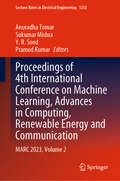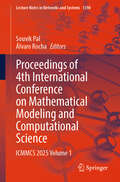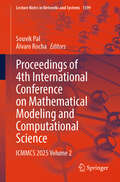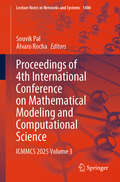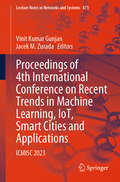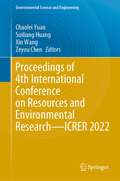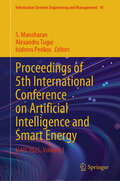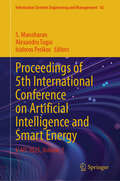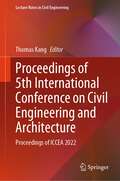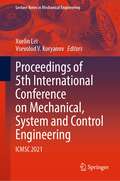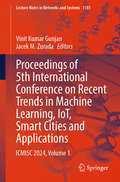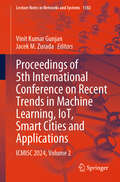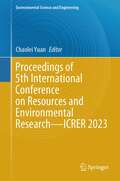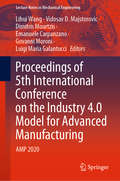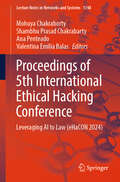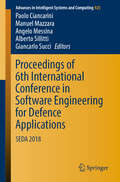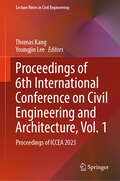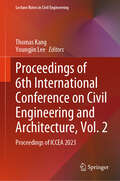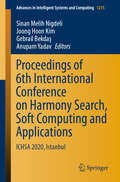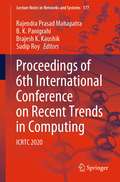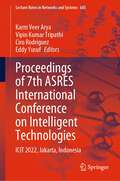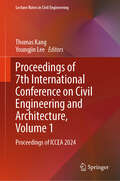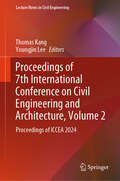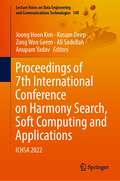- Table View
- List View
Proceedings of 4th International Conference on Machine Learning, Advances in Computing, Renewable Energy and Communication: MARC 2023, Volume 2 (Lecture Notes in Electrical Engineering #1232)
by Pramod Kumar Sukumar Mishra Anuradha Tomar Y. R. SoodThis book gathers selected papers presented at International Conference on Machine Learning, Advances in Computing, Renewable Energy and Communication (MARC 2023), held in Glocal University, Saharanpur, Uttar Pradesh, India, during 28–29 November 2023. This book discusses key concepts, challenges, and potential solutions in connection with established and emerging topics in advanced computing, renewable energy, and network communications.
Proceedings of 4th International Conference on Mathematical Modeling and Computational Science: ICMMCS 2025 Volume 1 (Lecture Notes in Networks and Systems #1398)
by Álvaro Rocha Souvik PalThis book aims to capture the interest of researchers and professionals in information technology, computer science, and mathematics. It covers fundamental and advanced concepts related to intelligent computing paradigms, data sciences, graph theory, and mathematical modeling. In high-performance computing, the need for intelligent, adaptive computing mechanisms and the integration of mathematical modeling in computational algorithms is becoming increasingly significant. Serving as a valuable resource for industry professionals, this book also supports beginners in gaining insights into enhanced computing paradigms and mathematical concepts, from foundational to advanced levels. Our objective is to provide a platform for researchers, engineers, academicians, and industry experts worldwide to share their findings on emerging trends. The authors believe this book not only presents innovative ideas but also fosters engaging discussions and inspires new perspectives.
Proceedings of 4th International Conference on Mathematical Modeling and Computational Science: ICMMCS 2025, Volume 2 (Lecture Notes in Networks and Systems #1399)
by Álvaro Rocha Souvik PalThis book aims to capture the interest of researchers and professionals in information technology, computer science, and mathematics. It presents fundamental and advanced concepts in intelligent computing paradigms, data science, graph theory, and mathematical modeling. As high-performance computing evolves, the emphasis on intelligent, adaptive computing mechanisms and the integration of mathematical modeling into computational algorithms is becoming increasingly vital. Serving as a valuable resource for professionals and newcomers alike, this book provides insights into enhanced computing paradigms and mathematical approaches, ranging from foundational to advanced levels. Our objective is to create a platform where researchers, engineers, academicians, and industry experts worldwide can exchange findings on emerging trends. Beyond introducing innovative concepts, the authors believe this book will spark meaningful discussions and inspire new ideas.
Proceedings of 4th International Conference on Mathematical Modeling and Computational Science: ICMMCS 2025, Volume 3 (Lecture Notes in Networks and Systems #1400)
by Álvaro Rocha Souvik PalThis book aims to capture the interest of researchers and professionals in information technology, computer science, and mathematics. It covers fundamental and advanced concepts related to intelligent computing paradigms, data sciences, graph theory, and mathematical modeling. In high-performance computing, the need for intelligent, adaptive computing mechanisms and the integration of mathematical modeling in computational algorithms is becoming increasingly significant. Serving as a valuable resource for industry professionals, this book also supports beginners in gaining insights into enhanced computing paradigms and mathematical concepts, from foundational to advanced levels. Our objective is to provide a platform for researchers, engineers, academicians, and industry experts worldwide to share their findings on emerging trends. The authors believe this book not only presents innovative ideas but also fosters engaging discussions and inspires new perspectives.
Proceedings of 4th International Conference on Recent Trends in Machine Learning, IoT, Smart Cities and Applications: ICMISC 2023 (Lecture Notes in Networks and Systems #873)
by Vinit Kumar Gunjan Jacek M. ZuradaThe book is a collection of the best-selected research papers presented at the International Conference on Recent Trends in Machine Learning, IoT, Smart Cities, and Applications (ICMISC 2023) held in September 2023 at the CMR Institute of Technology, Hyderabad, Telangana, India. This book will contain articles on current trends in machine learning, the internet of things, and smart city applications, emphasizing multi-disciplinary research in the area of artificial intelligence and cyberphysical systems. The book is a great resource for scientists, research scholars, and PG students to formulate their research ideas and find future directions in these areas. Further, this book serves as a reference work to understand the latest technologies used by practice engineers across the globe.
Proceedings of 4th International Conference on Resources and Environmental Research—ICRER 2022 (Environmental Science and Engineering)
by Xin Wang Chaolei Yuan Suiliang Huang Zeyou ChenWith the rapid increase of population, industrialization, urbanization, and the abuse of science and technology, environmental problems have showed an explosive development trend. Actions must be taken to ensure the rational exploitation and utilization of natural resources, prevent environmental pollution and ecological damage, and coordinate the relationship between environment and social development. Proceedings of 4th International Conference on Resources and Environmental Research (ICRER 2022) focuses on effective use of environmental resources, ecological restoration and remediation of degraded and polluted environment, and emission reduction technologies. This book brings the latest advances in resources and environmental research.
Proceedings of 5th International Conference on Artificial Intelligence and Smart Energy: ICAIS 2025, Volume 1 (Information Systems Engineering and Management #41)
by Isidoros Perikos Alexandru Tugui S. ManoharanThis book discusses the latest developments in computing techniques that power smart energy and sustainable solutions. Over the last few years, artificial intelligence (AI) has been more deeply embedded in our lives, revolutionizing industries and communication. Intelligent computing models are now transforming traditional energy applications in this digital age through smart automation, optimization, and adaptation. The book addresses major facets of intelligent computing and communication technologies, such as intelligent data analysis, predictive modeling, optimization, neural networks, AI, machine learning, deep learning, and the Internet of Things (IoT). All these technologies are discussed in practical applications, e.g., smart cities and smart industries, their transformative possibilities.
Proceedings of 5th International Conference on Artificial Intelligence and Smart Energy: ICAIS 2025, Volume 2 (Information Systems Engineering and Management #42)
by Isidoros Perikos Alexandru Tugui S. ManoharanThis book discusses the latest developments in computing techniques that power smart energy and sustainable solutions. Over the last few years, artificial intelligence (AI) has been more deeply embedded in our lives, revolutionizing industries and communication. Intelligent computing models are now transforming traditional energy applications in this digital age through smart automation, optimization, and adaptation. The book addresses major facets of intelligent computing and communication technologies, such as intelligent data analysis, predictive modeling, optimization, neural networks, AI, machine learning, deep learning, and the Internet of Things (IoT). All these technologies are discussed in practical applications, e.g., smart cities and smart industries, their transformative possibilities.
Proceedings of 5th International Conference on Civil Engineering and Architecture: Proceedings of ICCEA 2022 (Lecture Notes in Civil Engineering #369)
by Thomas KangThis book states that the proceedings gathers selected papers from 2022 5th International Conference on Civil Engineering and Architecture (ICCEA 2022), which was held in Hanoi, Vietnam on December 16-18, 2022. The conference is the premier forum for the presentation of new advances and research results in the fields of theoretical, experimental, and practical civil engineering and architecture. And this proceedings from the conference mainly discusses architectural design and project management, environmental protection and spatial planning, design and analysis of building materials, and structural engineering and safety. And these materials can be useful and valuable sources for researchers and professionals working in the field of civil engineering and architecture.
Proceedings of 5th International Conference on Mechanical, System and Control Engineering: ICMSC 2021 (Lecture Notes in Mechanical Engineering)
by Xuelin Lei Vsevolod V. KoryanovThis book comprises the proceedings of the 5th International Conference on Mechanical, System, and Control Engineering 2021. The contents of this volume focus on recent technological advances in the field of system dynamics and simulation, precision mechanics, production technology, structural dynamics, nanomaterial engineering, cloud computing and services, energy engineering and management, etc. This book proves a valuable resource for those in academia and industry.
Proceedings of 5th International Conference on Recent Trends in Machine Learning, IoT, Smart Cities and Applications: ICMISC 2024, Volume 1 (Lecture Notes in Networks and Systems #1181)
by Vinit Kumar Gunjan Jacek M. ZuradaThis book contains original, peer-reviewed research articles from the 5th International Conference on Recent Trends in Machine Learning, IoT, Smart Cities, and Applications, held in Hyderabad, India on 28–29 March 2024. It includes the most recent research trends and advancements in machine learning, smart cities, IoT, AI, cyber-physical systems, cybernetics, data science, neural networks, and cognition. This book addresses the comprehensive nature of AI, ML, and DL to highlight its role in the modelling, identification, optimisation, prediction, forecasting, and control of future intelligent systems.
Proceedings of 5th International Conference on Recent Trends in Machine Learning, IoT, Smart Cities and Applications: ICMISC 2024, Volume 2 (Lecture Notes in Networks and Systems #1182)
by Vinit Kumar Gunjan Jacek M. ZuradaThis book contains original, peer-reviewed research articles from the 5th International Conference on Recent Trends in Machine Learning, IoT, Smart Cities, and Applications, held in Hyderabad, India on 28–29 March 2024. It includes the most recent research trends and advancements in machine learning, smart cities, IoT, AI, cyber-physical systems, cybernetics, data science, neural networks, and cognition. This book addresses the comprehensive nature of AI, ML, and DL to highlight its role in the modelling, identification, optimisation, prediction, forecasting, and control of future intelligent systems.
Proceedings of 5th International Conference on Resources and Environmental Research—ICRER 2023 (Environmental Science and Engineering)
by Chaolei YuanThe field of resources and environmental research has seen a surge in interest and development. To compile the latest findings, this book presents peer-reviewed abstracts and papers from the 2023 5th International Conference on Resources and Environmental Research (ICRER 2023). This comprehensive collection offers insight into various areas including natural resource management, water resources and river basin management, solid waste management, soil, water, and air pollution control, climatic changes, ecosystem management, and sustainable development. This book provides professionals and researchers in the area of natural resources and environmental sciences with an up-to-date reference.
Proceedings of 5th International Conference on the Industry 4.0 Model for Advanced Manufacturing: AMP 2020 (Lecture Notes in Mechanical Engineering)
by Lihui Wang Vidosav D. Majstorovic Dimitris Mourtzis Emanuele Carpanzano Govanni Moroni Luigi Maria GalantucciThis book gathers the proceedings of the 5th International Conference on the Industry 4.0 Model for Advanced Manufacturing (AMP 2020), held in Belgrade, Serbia, on 1–4 June 2020. The event marks the latest in a series of high-level conferences that bring together experts from academia and industry to exchange knowledge, ideas, experiences, research findings, and information in the field of manufacturing. The book addresses a wide range of topics, including: design of smart and intelligent products, developments in CAD/CAM technologies, rapid prototyping and reverse engineering, multistage manufacturing processes, manufacturing automation in the Industry 4.0 model, cloud-based products, and cyber-physical and reconfigurable manufacturing systems. By providing updates on key issues and highlighting recent advances in manufacturing engineering and technologies, the book supports the transfer of vital knowledge to the next generation of academics and practitioners. Further, it will appeal to anyone working or conducting research in this rapidly evolving field.
Proceedings of 5th International Ethical Hacking Conference: Leveraging AI to Law (eHaCON 2024) (Lecture Notes in Networks and Systems #1148)
by Valentina Emilia Balas Mohuya Chakraborty Ana Penteado Shambhu Prasad ChakrabartyThis book constitutes refereed research works presented at International Ethical Hacking Conference, eHaCON 2024, the 5th international conference of its type to be held in Kolkata, India in March 2024. The eHaCON 2024 focuses on the new challenges and opportunities for the law created by the rise of Artificial Intelligence (AI). AI has significant implications for several broad societal issues, including investor protection, consumer protection, privacy, misinformation, and civil rights. Presently, AI is being used in various spectrums of the legal fraternity, such as drafting contracts, briefs, laws, regulations, and court opinions. It can also make enforcement and adjudication more effective.
Proceedings of 6th International Conference in Software Engineering for Defence Applications: SEDA 2018 (Advances in Intelligent Systems and Computing #925)
by Giancarlo Succi Alberto Sillitti Manuel Mazzara Paolo Ciancarini Angelo MessinaThis book presents high-quality original contributions on new software engineering models, approaches, methods, and tools and their evaluation in the context of defence and security applications. In addition, important business and economic aspects are discussed, with a particular focus on cost/benefit analysis, new business models, organizational evolution, and business intelligence systems. The contents are based on presentations delivered at SEDA 2018, the 6th International Conference in Software Engineering for Defence Applications, which was held in Rome, Italy, in June 2018. This conference series represents a targeted response to the growing need for research that reports and debates the practical implications of software engineering within the defence environment and also for software performance evaluation in real settings through controlled experiments as well as case and field studies. The book will appeal to all with an interest in modeling, managing, and implementing defence-related software development products and processes in a structured and supportable way.
Proceedings of 6th International Conference on Civil Engineering and Architecture, Vol. 1: Proceedings of ICCEA 2023 (Lecture Notes in Civil Engineering #530)
by Thomas Kang Youngjin LeeThe book presents the selected and peer reviewed papers of 2023 6th International Conference on Civil Engineering and Architecture (ICCEA 2023), held in Bali Island, Indonesia on December 16-18, 2023. This volume of proceedings includes a lot of smart and green solutions for challenges on civil infrastructure construction and architectural design. The book highlights attempts made by the researchers and practitioners to solve architectural planning issues by using state-of-the-art technologies and engaging in a lot of case studies and practices. This volume provides a valuable and useful reference for the people from both in academia and industry who are working in the field of civil engineering and architecture.
Proceedings of 6th International Conference on Civil Engineering and Architecture, Vol. 2: Proceedings of ICCEA 2023 (Lecture Notes in Civil Engineering #531)
by Thomas Kang Youngjin LeeThe book presents the selected and peer reviewed papers of 2023 6th International Conference on Civil Engineering and Architecture (ICCEA 2023), held in Bali Island, Indonesia on December 16-18, 2023. This volume of proceedings includes a lot of smart and green solutions for challenges on civil infrastructure construction and architectural design. The book highlights attempts made by the researchers and practitioners to solve architectural planning issues by using state-of-the-art technologies and engaging in a lot of case studies and practices. This volume provides a valuable and useful reference for the people from both in academia and industry who are working in the field of civil engineering and architecture.
Proceedings of 6th International Conference on Harmony Search, Soft Computing and Applications: ICHSA 2020, Istanbul (Advances in Intelligent Systems and Computing #1275)
by Anupam Yadav Gebrail Bekdaş Sinan Melih Nigdeli Joong Hoon KimThis book covers different aspects of real-world applications of optimization algorithms. It provides insights from the Sixth International Conference on Harmony Search, Soft Computing and Applications held at Istanbul University, Turkey, in July 2020. Harmony Search (HS) is one of the most popular metaheuristic algorithms, developed in 2001 by Prof. Joong Hoon Kim and Prof. Zong Woo Geem, that mimics the improvisation process of jazz musicians to seek the best harmony. The book consists of research articles on novel and newly proposed optimization algorithms; the theoretical study of nature-inspired optimization algorithms; numerically established results of nature-inspired optimization algorithms; and real-world applications of optimization algorithms and synthetic benchmarking of optimization algorithms.
Proceedings of 6th International Conference on Recent Trends in Computing: ICRTC 2020 (Lecture Notes in Networks and Systems #177)
by Rajendra Prasad Mahapatra B. K. Panigrahi Brajesh K. Kaushik Sudip RoyThis book is a collection of high-quality peer-reviewed research papers presented at Sixth International Conference on Recent Trends in Computing (ICRTC 2020) held at SRM Institute of Science and Technology, Ghaziabad, Delhi, India, during 3 – 4 July 2020. The book discusses a wide variety of industrial, engineering and scientific applications of the emerging techniques. The book presents original works from researchers from academic and industry in the field of networking, security, big data and the Internet of things.
Proceedings of 7th ASRES International Conference on Intelligent Technologies: ICIT 2022, Jakarta, Indonesia (Lecture Notes in Networks and Systems #685)
by Karm Veer Arya Ciro Rodriguez Vipin Kumar Tripathi Eddy YusufThis book gathers the proceedings of the 7th International Conference on Intelligent Technologies (ICIT 2022) held on December 16-18, 2022, at the University of Pembangunan Jaya, Jakarta, Indonesia. The respective contributions from industrial practitioners and researchers present advanced studies related to application of intelligent technologies in various fields of research industry and society. This includes applications in variety of fields such as computational intelligence, data science and engineering, communication and networking, signal and image processing, electrical devices, circuits systems, robotics, instrumentation, automation, biomedical, and health care.
Proceedings of 7th International Conference on Civil Engineering and Architecture, Volume 1: Proceedings of ICCEA 2024 (Lecture Notes in Civil Engineering #640)
by Thomas Kang Youngjin LeeThis book states that the proceedings gathers selected papers from 7th International Conference on Civil Engineering and Architecture (ICCEA 2024), which was held in Da Nang, Vietnam on December 7-9, 2024. The conference is the premier forum for the presentation of new advances and research results in the fields of theoretical, experimental, and practical civil engineering and architecture. And this proceedings from the conference mainly discusses architectural design and project management, environmental protection and spatial planning, design and analysis of building materials, and structural engineering and safety. And these materials can be useful and valuable sources for researchers and professionals working in the field of civil engineering and architecture.
Proceedings of 7th International Conference on Civil Engineering and Architecture, Volume 2: Proceedings of ICCEA 2024 (Lecture Notes in Civil Engineering #641)
by Thomas Kang Youngjin LeeThis book states that the proceedings gathers selected papers from 7th International Conference on Civil Engineering and Architecture (ICCEA 2024), which was held in Da Nang, Vietnam on December 7-9, 2024. The conference is the premier forum for the presentation of new advances and research results in the fields of theoretical, experimental, and practical civil engineering and architecture. And this proceedings from the conference mainly discusses architectural design and project management, environmental protection and spatial planning, design and analysis of building materials, and structural engineering and safety. And these materials can be useful and valuable sources for researchers and professionals working in the field of civil engineering and architecture.
Proceedings of 7th International Conference on Harmony Search, Soft Computing and Applications: ICHSA 2022 (Lecture Notes on Data Engineering and Communications Technologies #140)
by Anupam Yadav Kusum Deep Joong Hoon Kim Zong Woo Geem Ali SadollahThe book covers different aspects of real-world applications of optimization algorithms. It provides insights from the Seventh International Conference on Harmony Search, Soft Computing and Applications held at Virtual Conference, Seoul, South Korea, in February 2022. Harmony search (HS) is one of the most popular metaheuristic algorithms, developed in 2001 by Prof. Joong Hoon Kim and Prof. Zong Woo Geem, that mimics the improvisation process of jazz musicians to seek the best harmony. The book consists of research articles on novel and newly proposed optimization algorithms; the theoretical study of nature-inspired optimization algorithms; numerically established results of nature-inspired optimization algorithms; and real-world applications of optimization algorithms and synthetic benchmarking of optimization algorithms.
Proceedings of 8th ASRES International Conference on Intelligent Technologies: ICIT 2023, Jakarta, Indonesia (Lecture Notes in Networks and Systems #1031)
by Karm Veer Arya Ciro Rodriguez Vipin Kumar TripathiThis book gathers the proceedings of the 8th International Conference on Intelligent Technologies (ICIT) held on December 15–17, 2023, at the Matana University, Jakarta, Indonesia. The respective contributions from industrial practitioners and researchers present advanced studies related to the application of intelligent technologies in various fields of research industry and society. This includes applications in a variety of fields such as computational intelligence, data science and engineering, communication and networking, signal and image processing, electrical devices, circuits systems, robotics, instrumentation, automation, biomedical, and health care.
